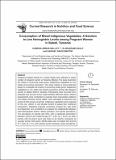| dc.description.abstract | Pregnancy-related anemia is a critical health issue affecting a larger number of pregnant women in Tanzania affected. The study examined the impact of consuming locally grown indigeneous vegetables on iron intake and anemia prevention. The study utilized a cross-sectional design to investigate the impact of consuming locally grown indigenous vegetables on iron intake and anemia prevention among 340 pregnant women in Babati District, Tanzania. Participants were recruited from antenatal care services at four health facilities within the district. Dietary assessments were conducted to evaluate food consumption patterns and Dietary Diversity Scores (DDS).were calculated to determine the variety of food groups consumed. Indigenous vegetables were analyzed for the iron, vitamin C, and phytate content to assess their nutritional composition. Statistical analyses conducted included Chi2 (χ2) tests and Spearman rank correlations to evaluate the relationships between socio-demographic factors, dietary practices, and anemia prevalence. The prevalence of anemia was 45%, with a significant association between anemia and maternal age (P < 0.04, χ2 = 6.43), as older women (36–49 years) were less likely to be anemic compared to younger women (≤35 years). Marital status also correlated with anemia (P < 0.04, χ2 = 4.1), with married women showing a lower prevalence. Dietary diversity was limited, with only 55.6% of participants consuming five or more food groups (DDS ≥ 5). Indigenous vegetables, such as sweet potato leaves and amaranth combined with lemon juice, showed high vitamin C content (43.2 ± 0.26 mg/g), enhancing iron absorption. Hygiene practices like hand washing after toilet use were associated with reduced anemia risk (P < 0.0022, χ2 = 9.352). This study highlights the importance of indigenous vegetables, dietary diversity, and good hygiene in reducing anemia among pregnant women in rural Tanzania, emphasizing the need for nutrition education and improved access to iron-rich foods. | en_US |

